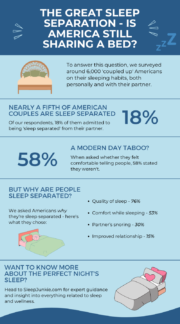How Sleep Changes with Age: From Children to Teens to Adults
Ever wonder why babies don’t readily sleep through the night or why toddlers seem to become afraid of monsters under the bed? How about why teens always seem to oversleep their alarms or why grandpa takes so many naps? Or perhaps even why your own slumber fluctuates as overtime?
Find out the answer to these questions, and learn more about how sleep changes through the years based on science and views from sleep experts.
Sleep Needs Vary Significantly By Age
Newborns, infants, and toddlers require more sleep, and they have more variable sleep patterns than older children. Teenagers need more sleep than adults as their bodies go through a period of tremendous change. We get our best sleep in early adulthood before the quality and quantity tapers off as we age.
The National Sleep Foundation has consulted with scientists in various fields to update the recommended sleep durations. Most sleeping still takes place during the night when melatonin production is higher. But, babies and younger children nap during the day as well to accumulate sleeping hours in a 24-hour period.
The ranges are large enough to accommodate most of the population. Of course, some outliers get by fine on more or less than the recommended amount. This is a rarity linked to gene variants or illness, however. The vast majority should be sleeping within the recommended guidelines on a regular basis to avoid the negative effects of sleep deprivation.
Newborns
Circadian rhythms, the sleep-wake cycles regulated by dark and light, take about 8 weeks to develop and 3-6 months to standardize. Between sleep, babies are often active. But, they require 14 – 17 hours of sleep per 24 hours in their first three to four months.
Newborns express their need to sleep by fussing, crying, rubbing their eyes, or exhibiting similar actions. They may experience separation anxiety, which can disrupt sleep. Their sleep cycle is intertwined with other basic needs: feeding, diaper changing, and nurturing (which often disrupts parents’ sleep).
Infants
Sleep need decreases to between 12 and 15 hours when they are 4 to 11 months. By the age of 3 months, infants start to consolidate their nightly sleep period, most can sleep 8 hours by a 6-month age. Usually, infants take one to four naps per day that last between 30 minutes and 2 hours. If you put them to bed when they are drowsy, rather than asleep, they will more easily develop sleep independence instead of signaling their parents.
Establishing a routine and having a friendly sleep environment is helpful for improving sleep across all ages & may help babies between the ages of 4 and 11 months fall asleep independently. Exposing them to light and noise during the day, and quieting down towards the night helps them adjust to more regular sleeping hours.
At night, place them on their back, clear of blankets or other soft objects. You don’t want to give a baby a pillow too early for their safety, after all.
Adequate rest proves very important for babies, as plenty is going on in the brain and body during these crucial months. Babies spend between 24-32% of their sleep time in Rapid Eye Movement (REM) sleep.
REM sleep is when our brains are highly active and when most dreaming occurs. Breathing and heart rate can become irregular and our bodies, immobile, referred to as muscle atonia, which allows us to dream without physically acting them out. During non-REM sleep blood supply to muscles increases, energy is restored, tissue growth and repair occur, and important hormones are released for growth and development.
Toddlers
Toddlers between the ages of 1 and 2 years experience a time of increased motor, cognitive, and social abilities. They are establishing imagination and independence, which affects their sleep habits.
With independence comes a pushback on going to sleep. The best approach is to communicate consistent limits about bedtime and nap time. Toddlers need between 11 and 14 hours of sleep.
The development of imagination may contribute to nightmares and nighttime fears, which explains the monsters under the bed. A security object, such as a blanket, can make your toddler less afraid.
Preschoolers and School-Aged Children
By the time children hit the preschool age, between 3 and 5 years, their REM sleep has decreased. Parents often phase naps out of the routine for school, with most children after 5 forgoing sleep in the daytime.
Preschoolers face many of the same issues as toddlers. School-aged children also face increasing demands on their time between homework, television, sports, and computers.
If children have poor sleeping habits, they may demonstrate behavior problems such as mood swings or an inability to focus and learn at school. One study of ours examines child’s bedtime habits and sleep recommendations.
With sleep deprivation, adults get sleepy, while kids often act the opposite. They tend to overcompensate for their tiredness by exhibiting signs of hyperactivity, inattentiveness, and impulsive behavior, which may be misdiagnosed as ADHD. According to researchers, children with inconsistent sleep schedules & short sleep duration experienced behavioral difficulties.
SEE ALSO: Best Mattresses for Kids
Teenagers
Wondering why your teen resists going to bed at night and is so difficult to wake them in the morning? Part of it is because their circadian rhythm shifts, causing a delay in sleep timing. This shift brings a tendency to sleep and wake later. Due to this natural circadian shift, many sleep researchers have suggested that school times should actually start later in the morning to accommodate for these biological changes during adolescence.
Although teens need between 8 and 10 hours of sleep, most aren’t getting enough. Sleep patterns may be irregular between weekdays and weekends when they stay up later and sleep in without having to wake up for school. A teenager’s high school sleep habits can be quite poor.
The good news is that most of the sleep that teens and younger adults experience is slow-wave sleep, which is the most restorative. However, if teens aren’t getting enough sleep at night it can make it harder to pay attention in school, lead to poor eating habits, contribute to inappropriate or aggressive behaviors, or even aggravate feelings of depression, stress and anxiety.
Avoiding electronics one hour before bedtime can help teens get to sleep earlier. The blue-wave light emitted by phones, tablets, and TVs is disruptive to melatonin production.
SEE ALSO: Best Mattresses for Teenagers
Sleeping as an Adult
The most satisfying and restorative sleep takes place when you are a young adult. In your early twenties, you get most Stage III (slow-wave) sleep, which is the deepest and most restorative. After your early 20s you spend more of the night in Stage II sleep, or middle sleep, which is mildly restorative.
As you get older, your sleep can become less satisfying and less restorative. And, the modern pace of life means adults are often not getting enough sleep.
Sleep often mirrors your general health. The better your health the better you may sleep, and vice versa. For example, regular exercise can improve sleep.
Women also experience unique disruptions in sleep throughout their adult lives. Events like pregnancy, motherhood, and menopause all play a role in the quality of rest.
Aging & Seniors
The circadian clock may have less “power” over our sleep as we age into older adulthood. As such, many older adults prefer to wake earlier in the morning and sleep earlier at night.
Health issues and aging can hinder older adults’ sleep patterns. Sore backs, hips, and knees keep people awake, as might other physical or psychiatric illnesses or the medications treating them.
Seniors may have a harder time falling asleep. They also wake frequently during the night, fragmenting sleep and deregulating the circadian clock. With age, the body spends more time in the lighter stages of sleep, meaning more total rest time is needed to fully recharge. So, it’s no wonder seniors like to nap in the day! However, many things can be done to improve sleep at any age. Light therapy and exercise can help, as well as healthy sleep habits.
Changes in sleep patterns are a normal part of aging. Aiming to make a healthy amount of rest part of your daily routine, practicing good sleep hygiene, and emphasizing its importance as a family can help develop lifelong habits.
Maintaining good sleep hygiene and avoiding bad sleep habits are important aspects of quality sleep. We suggest sticking to regular sleep and wake times. Go to bed when you’re sleepy and avoid other activities while lying or sitting in bed.
Also, doing other activities n bed like reading, working on a laptop, or watching TV, can lead to sleep problems in the long run. Over time, the association the brain makes connecting the bed to sleep may decrease, making it harder to fall and stay asleep.
Check out our recent guides to staying cool during sleep and the top mattresses of 2024 for more on getting better rest.


